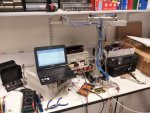Good morning,
I have been building a controller for a robot arm project, and it uses limit switches at each axis move.
So I have been if pin = 0 then motor On.. If = 1 then stop motor..
Problem is sometimes it misses, or if i start the robot up after an incomplete cycle it misses the fact that its reached the limit already.
Is there a way to set a latch, and then check the latch? Is it possible to set and read a latch in memory after a power re-set?
Any advice would be great.
I have been building a controller for a robot arm project, and it uses limit switches at each axis move.
So I have been if pin = 0 then motor On.. If = 1 then stop motor..
Problem is sometimes it misses, or if i start the robot up after an incomplete cycle it misses the fact that its reached the limit already.
Is there a way to set a latch, and then check the latch? Is it possible to set and read a latch in memory after a power re-set?
Any advice would be great.

